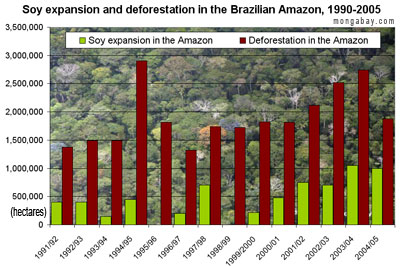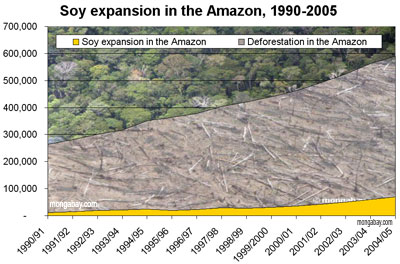Rural population decline may not slow deforestation
Rural population decline may not slow deforestation
mongabay.com
June 3, 2007
A new paper shoots down the theory that increasing urbanization will lead to increasing forest cover in the tropics.
Writing in the July issue of the journal Biotropica, Sean Sloan, a researcher from McGill University in Montreal, argues that anticipated declines in rural populations via urbanization will not necessarily result in reforestation–a scenario put forth in a controversial paper published in Biotropica last year by Joseph Wright of the Smithsonian Tropical Research Institute in Panama and Helene Muller-Landau of the University of Minnesota. Wright and Muller-Landau (WLM) said that deforestation rates will likely slow, then reverse, due to declining rural population density in developing countries.
Drawing on research from Panama and the Amazon, Sloan says that Wright and Muller-Landau fail to account for land-use “extensification” resulting from population decline as well as new drivers–notably large-scale agriculture–that are “increasingly diminishing the role of local population” in deforestation.

|
Sloan cites examples in the Darien region of Panama where peasant colonists abandoned their lands for agriculture only to have a small population remain and convert their land to pasture, thereby “extensifying” land use.
“30 percent or more of an agricultural population may abandon their lands while those who remain suppress regrowth by expanding over the formers’ lands and into surrounding forest,” he writes. “In the southern Bayano Region, the Darién’s most populous front, this stage has been underway since 1990; between 1990 and 2000, the population decreased by nearly 20 percent, but pasture area increased by nearly 50 percent and the number of cattle by 100 percent”
Sloan says a similar transformation has been observed in the Bolivian Amazon, the where diminished presence of subsistence slash-and-burn agriculturists were more than offset by an influx of large-scale Mennonite soy farmers.
“Despite slash-and-burn farmers’ diminished presence, regrowth was suppressed more extensively as successive land uses maintained previously cleared land in increasingly wide-open expanses,” he writes.

Note: some soybean farms are established on already degraded rainforest lands and neighboring cerrado ecosystems. Therefore it would be inappropriate to assume the area of soybean planting represents its actual role in deforestation. |
Sloan says that increasing demand for meat and grains for animal feed will further drive forest conversion.
“The growing influence of non-local drivers of land-cover change is expected to perpetuate such a dynamic in coming years,” he explains. Increasing demand for meat and (feed) grains, both at home and abroad but particularly by newly affluent nations, is expected to favour further expansion into Neotropical frontiers rather than agricultural intensification, owing to a land abundance, prevailing farm systems and demographic and social conditions which favour expansion.”
Sloan concludes by stating that deforestation is likely to increase, not decrease in the future, due to these trends.
“In places like the Amazon, in fact, most deforestation is caused by large-scale interests, such as large commercial ranches, that due to their expansive and extensive nature have inverse relationships with local population density. Though smallholders do play a not-insignificant role in deforestation, it is, in such contexts, relatively little and often in synergy with these larger landholders. With globalization, this relationship, and not the peasant-economy that WML speak of, will increasingly characterize deforestation in forest frontiers, at least in Latin America. Where it does not, that is, where large-scale, expansive commercial interests are largely absent and small peasants populate a forested landscape, WML’s predictions are more tenable.”
CITATION: S. Sloan (2007) “Fewer People May Not Mean More Forest for Latin American Forest Frontiers”. Biotropica, online 23-May-2007 doi: 10.1111/j.1744-7429.2007.00288.x